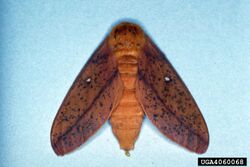Biology:Anisota peigleri
| Anisota peigleri | |
|---|---|

| |
| Scientific classification | |
| Domain: | Eukaryota |
| Kingdom: | Animalia |
| Phylum: | Arthropoda |
| Class: | Insecta |
| Order: | Lepidoptera |
| Family: | Saturniidae |
| Genus: | Anisota |
| Species: | A. peigleri
|
| Binomial name | |
| Anisota peigleri Riotte, 1975
| |
Anisota peigleri, the yellowstriped oakworm, is a moth of the family Saturniidae. The species was first described by Jules C. E. Riotte in 1975. It is found in the United States from south-eastern Kentucky, south-western Virginia, eastern Tennessee and western North Carolina south through western South Carolina and central Georgia into north-central Florida.
It was described as a species in 1975 and is similar to and was previously identified as Anisota senatoria (J.E. Smith, 1797).
The wingspan is 43–69 mm. Adults are on wing from mid July to late August in one generation. Adults are on wing during the day. Mating takes place from midmorning until midafternoon.
The larvae mainly feed on various oak species, including Quercus palustris. They feed in tight groups throughout their development. Fully grown caterpillars pupate and overwinter in shallow underground chambers. Adults do not feed.
It is an occasional pest on oak trees in the south-eastern United States. In Florida, outbreak populations defoliated laurel, water and Shumard oaks in Gainesville from 1996 until 2001. Even when defoliation is not severe, the falling frass (droppings) and large numbers of caterpillars are a major concern for many homeowners. Frass commonly stains driveways, walkways, pool decks and other outdoor structures.[1]
References
External links
| Wikimedia Commons has media related to Anisota peigleri. |
- Species info
- Butterflies and Moths of North America
- Natural History of Anisota peigleri (Lepidoptera: Saturniidae) in Gainesville, Florida
Wikidata ☰ Q1349718 entry
 |

